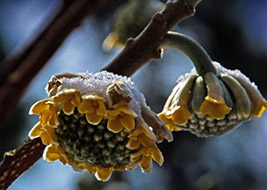“EVEN IF SOMETHING IS LEFT UNDONE, EVERYONE MUST TAKE TIME TO SIT STILL AND WATCH THE LEAVES TURN.” — ELIZABETH LAWRENCE

- Trees & Shrubs
- PRIME TRANSPLANTING TIME for deciduous trees and shrubs continues into this month.
- Remove any dead or diseased branches. Mulch well and protect if frost is predicted before the plant is established. Check this publication for mulching techniques http://pubs.ext.vt.edu/426/426-724/426-724.html.
- If you have viburnum, check for viburnum beetle eggs in the branches and remove.
- Remain diligent in your clean up around fruit trees to avoid providing housing for wintering insects.
- Annuals, Perennials & Shrubs
- Cannas, Dahlias and other tender bulb-like things including elephant ears need to be dug carefully for indoor storage. There are many methods to store, but basicallyonce frost blackens the foliage, cut back the tops to 6 inches and dig carefully, then brush or wash off soil and let dry for two weeks or so to cure. Store in a dry spot like unheated basement or crawl space around 40-50 degrees, in boxes or pots filled with bark chips or peat moss.
- After chrysanthemums are killed by frost, cut them down in preparation for winter. Apply a 2- to 3-inch layer of loose mulch, such as leaves, after the ground has frozen.
- Plant pansies and violas.
- Sow poppy seeds now for flowers next May.
- Fruits, Vegetables & Herbs
- Prepare your seedbed now for peas and spinach for next spring, to get a head start on such early crops.
- Spinach can even be sown this month, for super-early spring harvest (don’t plant the peas yet, though).
- If next year’s garden plans include a patch of strawberries or asparagus, do the tilling and soil preparation now so the bare-root plants ordered over the winter can be planted extra early come spring.
- Mulch strawberry plants with straw.
- If you haven’t gotten your garlic in, you can still prepare a sunny spot, and plant each clove 1-2 inches deep and 6 inches apart in the row, with about 12 inches between rows.
- Cut asparagus to the ground after the tops turn brown. Mulch plants with clean straw.
- Try this for easy-access to your mint: put a clump of mint in a pot and let it freeze one time. Bring it indoors for snipping throughout the winter.
This and That
- Start a leaves-only compost pile alongside your other heap as a future source of soil-improving leaf mold, or when partly rotted for use as mulch. To speed up decomposition, run it over with the mower to pre-shred. You may also use the leaves as mulch to protect plants.
- Keep the compost heap moist to aid in the decay process. Turn the pile to mix in all late, fall additions. Tip: add fertilizer residues from nearly empty bags onto the pile and mix.
- Keep your shears and loppers in good working order. Wipe them with a rag dipped in paint thinner to remove sticky resins. Sharpen and oil thoroughly. Try this: Place some sand and some oil in a large bucket, then slide your garden tools in and out of the sand.
For Fun!
- Start a pot of paperwhites in potting soil or pebbles and water and you’ll have blooms for Christmas. Stagger forcing of another batch every couple of weeks for a winterlong display.
- Try this different way of starting an avocado plant: Remove the pit from the fruit and wrap it in a moist paper towel, then place it in a plastic bag and close the bag. Place this package in a warm place, checking on it every few days to see if the towel needs to be moistened. When roots appear, pot it up.
- Add bird feeders to bring lots of color and activity to the winter garden. Black oil sunflower seeds attract the best variety of birds and you’ll likely find lots of sunflowers growing where you never planned them to grow come summertime!
Did you know…
- Earthworms must remain below the frost line to survive. Mulch, piled on top of soil, raises the frost line. If you want earthworms to help break down organic matter in the upper soil layers, mulch deeply. If you need the subsoil aerated, leave the surface mulch thin; the worms will burrow downward to stay warm.
Back to This Month in the Garden
January February March April May June July August September October November December
